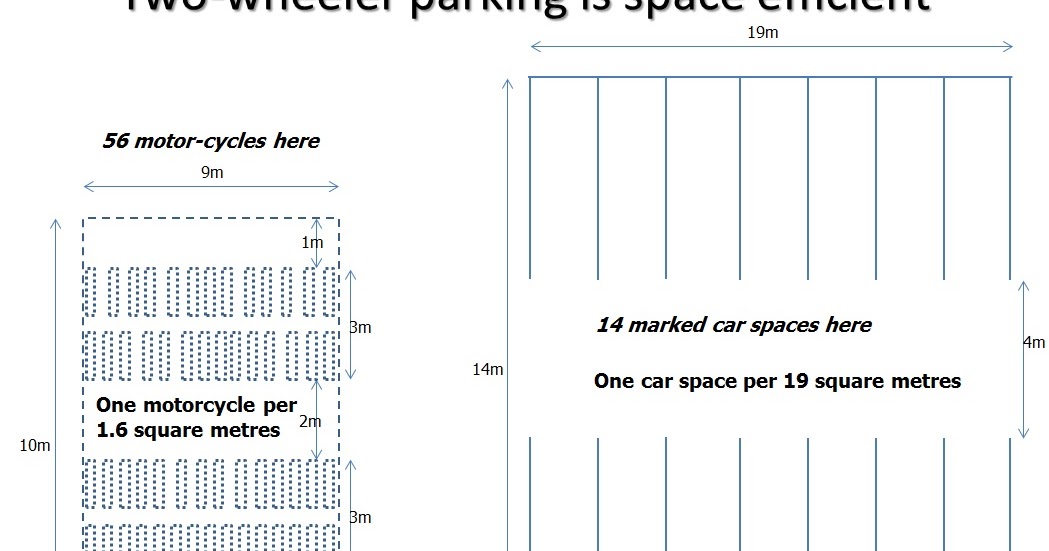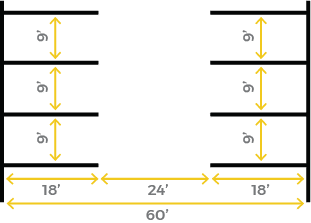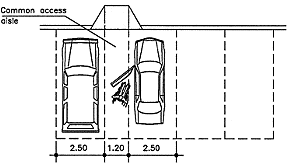Parking Slot Measurement
The parking lot purpose can also inform the angles of your parking stalls or slots, as we’ll discuss further below. High turnover parking lots typically have spaces at 45 to 60-degree angles. It’s more difficult to park in a space at a 90-degree angle, so those are usually reserved for full-day or overnight parking. The only parking spaces that are mandated federally in the U.S. Are handicap spaces. Van-accessible spaces must be 11 feet wide, and standard handicap spaces must be at least 8 feet wide. DataTubes are wireless vehicle detection sensors that can be used for off-line traffic surveys. Detection resuls are stored inside the sensor node that is mo. Where the size and shape of the tract is appropriate, both the 90 o and the 60 o parking layouts tend to require the smallest area per car space. In typical lot layouts for large size vehicles, the average overall area required (including cross aisles and entrances) ranges between 310 and 330 square feet/car.
The standard parking spot size varies according to country. In the United States, parking lots must have a minimum width of 9 feet (around 2.7 meters). Given that the average width of a car is 6 feet, that provides you with around 1.5 feet on either side of the car as allowance, assuming you’ve parked your vehicle properly.
A parking space is a location that is designated for parking, either paved or unpaved. It can be in a parking garage, in a parking lot or on a city street. The space may be delineated by road surface markings. The automobile fits inside the space, either by parallel parking, perpendicular parking or angled parking.
Depending on the location of the parking space, the time allowed to park may be fixed by regulation, and a fee may be required to use the parking space. It may be designated for free parking. When the demand for spaces outstrips supply vehicles may overspill park onto the sidewalk, grass verges and other places which were not designed for the purpose.[1]
Patterns[edit]
For most motorised vehicles, there are three commonly used arrangements of parking spaces—parallel parking, perpendicular parking, and angle parking. These are self-park configurations where the vehicle driver is able to access the parking independently.
Parallel parking[edit]
With parallel parking of cars, these are arranged in a line, with the front bumper of one car facing the back bumper of an adjacent one. This is done parallel to a curb, when one is provided. Parallel parking is the most common mode of streetside parking for cars. It may also be used in parking lots and parking structures, but usually only to supplement parking spaces that use the other modes.
Perpendicular parking[edit]
With perpendicular parking, also known as bay parking, cars are parked side to side, perpendicular to an aisle, curb, or wall. This type of car parking fits more cars per length of road (or curb) than parallel parking, and is therefore commonly used in car parking lots and car parking structures.
Often, in car parking lots using perpendicular parking, two rows of parking spaces may be arranged front to front, with aisles in between. If no other cars are blocking, a driver may perform a 'pullthrough' by driving through one parking space into the connecting space to avoid having to reverse out of a parking space upon their return.
Parking Slot Measurement Ford
Sometimes, a single row of perpendicular car parking spaces is marked in the center of a street. This arrangement eliminates reversing from the manoeuvre; cars are required to drive in forwards and drive out forwards.
Angle parking/echelon parking[edit]
Angle parking, known as echelon parking in Britain, is similar to perpendicular parking for these vehicles, except that cars are arranged at an angle to the aisle (an acute angle with the direction of approach). The gentler turn allows easier and quicker parking, narrower aisles, and thus higher density than perpendicular parking. While in theory the aisles are one-way, in practice they are typically wide enough to allow two cars to pass slowly when drivers go down the aisles the wrong way.
Angle parking is very common in car parking lots. It may also be used in streetside car parking in the U.S. when there is more width available for car parking than would be needed for parallel parking of cars, as it creates a larger number of parking spaces. Some cities have utilized angled parking on-street (as compared to off-street parking facilities). This has been done mostly in residential, retail and mixed use areas where additional parking compared to parallel parking is desired and traffic volumes are lower. Most angled parking is design in a head-in configuration while a few cities (Seattle, Portland, Baltimore, and Indianapolis are examples) have some back-in angled parking (typically on hills or low traffic volume streets).
Angle parking is considered dangerous by cycling organisations, especially in the head-in configuration, but unwelcome in either form. When comparing to parallel parking:
- There is a significant risk to cyclists from vehicles reversing out, as approaching bicycles are in the blind spot of the reversing and turning vehicles.[2]
- Longer vehicles project further into the road; this can inconvenience/endanger other road users,
- The 'surplus' road space which enables angle parking could also be used for bicycle lanes.
Hence organisations such as the Cyclists Touring Club are usually opposed to all proposed echelon parking schemes, though there are some alternatives, such as back-in angle parking (slanted the 'wrong' way, with the driver reversing into the space, rather than reversing out), which can overcome many of the issues of safety.
Other parking methods[edit]
Besides these basic modes of motor vehicle parking, there are instances where a more ad hoc approach to arranging motor vehicles is appropriate. For example, in parts of some large cities, such as Chicago and Bangalore, where land is expensive and therefore parking space is at a premium, there are formal and informal parking lots for motor vehicles where the driver leaves the keys to the vehicle with an attendant who arranges vehicles so as to maximize the number of vehicles that can be parked in the lot. Vehicles may be packed up to five vehicles deep in combinations of perpendicular and/or parallel parking with limited circulation aisles for the parking attendant. Such arrangements are known as attendant parking. When the lot or facility is provided to serve the customers of a business, it is considered valet parking.
Inner city parking lots are often temporary, the operators renting land which is vacant pending the construction of a new office building. Some inner city lots are equipped with individual lifts, allowing cars to be stored above each other.
Another ad hoc arrangement is tandem parking. This is sometimes done with residential motor vehicle parking where two motor vehicles park nose-to-end in tandem. The first motor vehicle does not have independent access, and the second motor vehicle must move to provide access. As with attendant parking, the purpose is to maximize the number of motor vehicles that can park in a limited space. Formalised tandem parking will sometimes be sanctioned by local planning authorities for staff parking arrangements require additional parking in limited spaces.
Marks and space size[edit]
In parking lots (car parks in British English), parking is allowed only where marked.[3]
In the US, minimum width standards of parking spaces usually range from 8.5 to 9.0 feet (2.6–2.7 m). Angled and perpendicular spaces may need to be wide to allow doors to open, while parallel parking spots may be narrower on low-traffic neighborhood streets.
Because the boundary between parking space and driving area is not always well-defined, the length of a parking space is more difficult to establish. However, most angled and perpendicular spaces are considered to be between 10 and 18 feet (3.0–5.5 m) in length. In the United States, due to vehicles being larger on average than some other countries[citation needed], a parking space 10 feet (3.0 m) deep is uncommon and most parking spaces will be within 16 to 20 feet (4.9–6.1 m), with 19 feet (5.8 m) feet deep being the standard DOT recommended depth for standard perpendicular parking[citation needed]. Parallel parking spaces typically range from 20 to 24 feet (6.1–7.3 m) long.
During construction, the specific dimensions of a parking space are decided by a variety of factors. A high cost of land will encourage smaller dimensions and the introduction of compact spaces.[4] Many garages and parking lots have spaces designated for a Compact car only. These spaces are narrower than traditional spaces, thus allowing more cars to park.[5]
According to French standard 'Norme NF P 91-100', minimum width of parking spaces range from 2.20 to 2.30 metres (7.2–7.5 ft) (See fr:Marquage du stationnement en France). Narrow parking spaces such as in Vevey, Switzerland, might make opening the door difficult in a larger vehicle.
Larger cars are an issue when the size of the bay is fixed. Automobile associations warn of this issue.[6] A Swiss Association regulating parking space wants to consider this issue for 2016. [needs update]
In the United Kingdom, the recommended standard parallel bay size is 2.4 metres (7.9 ft) wide by 4.8 metres (16 ft) long. Recently there has been some controversy about most UK parking spaces being too small to fit modern cars, which have grown significantly since standards were set decades ago.[7]
In Australia, the dimensions are defined in AS2890 and are 2.4 m wide by 5.4 m long.[8]
Barriers[edit]

Parking spaces commonly contain a parking chock (wheel stop), which is used to prevent cars from pulling too far into the space and
- obstructing a neighboring parking space, curb, or sidewalk.
- contacting with and then damaging a building wall.
This barrier is usually made of concrete and will normally be a horizontal bar to stop the tires from moving forward or a vertical bar that may cause damage to the vehicle if contact is made. In a parking garage, the barrier will often be a concrete wall.
Parking spaces for the disabled[edit]
Some parking spaces are reserved as handicapped parking, for individuals with disabilities. Handicapped parking spaces are typically marked with the International Symbol of Access, though in practice, the design of the symbol varies widely.[9]
In the United States the Access Board provides guidelines on parking spaces.[10][11]
Women's parking spaces[edit]

In some countries, women's parking spaces have been established in more visible spots to reduce the chance of sexual attacks,[12] facilitate parking for women, or to provide spaces that are closer to shopping centers or employment.[13][14]
US curb markings[edit]

Curb markings in the United States are prescribed by the Manual of Uniform Traffic Control Devices (MUTCD).[15] Local highway agencies may prescribe special colors for curb markings to supplement standard signs for parking regulation. California has designated an array of colors for curb regulations. A white curb designates passenger pick up or drop off. The green curb is for time limited parking. The yellow curb is for loading, and the blue curb is for disabled persons with proper vehicle identification. The red curb is for emergency vehicles only - fire lanes (no stopping, standing, or parking). In Oregon and Florida, the yellow curb is utilized to indicate no parking. In Georgia either red or yellow can be used to indicate no parking. In Seattle, Washington, alternating red and yellow curb markings indicate a bus stop.
See also[edit]
- Parking chair (for snowstorms)
References[edit]
- ^'Possible kerb-space management solutions'. Dartford Borough Council. Archived from the original on 2012-02-21. Retrieved 2009-07-25.
- ^UK Department of Transport Cycle Infrastructure Design
- ^'Parking spaces'. Homes for Students - HOAS. Retrieved 2019-07-28.
- ^A Comprehensive Menu of Solutions to Parking Problems Victoria Transport Policy Institute
- ^'Houston Parking Lot Line Striping, Parking Lot Maintenance'. Archived from the original on 2013-11-05.
- ^Pierren, Sophie (2012-09-09). 'Places de parc trop petites pour grosses voitures'. 20 Minutes (in French). Retrieved 2012-09-15.
- ^'UK parking bays too small'. Archived from the original on 2015-04-02.
- ^'AS_NZS 2890: Parking Facilities Set'. SAI Global. Retrieved 2018-01-30.
- ^www.youcantparkhere.com A gallery of handicapped parking symbols.
- ^'ADAAG - United States Access Board'.
- ^Revised Draft Guidelines for Accessible Public Right-of-Way and ADA Accessibility Guidelines for Buildings and Facilities (ADAAG)Archived 2011-05-14 at the Wayback Machine
- ^FAQ of the German Federal Anti-Discrimination Agency (archived)
- ^Will High-Heel-Friendly Streets Keep Seoul's Women Happy?, Time, 2009
- ^Le Monde (fr) article about women's parking spaces in China
- ^Manual of Uniform Traffic Control Devices, FHWA, 2009, Section 3B-23.
External links[edit]
| Wikimedia Commons has media related to Parking. |
Parking Stall Layout Considerations
The objective of the layout design is to maximize the number of stalls, while following the guidelines below.
- The layout of the parking facility must be flexible enough to adapt to future changes in vehicle dimensions.
- The stall and aisle dimensions must be compatible with the type of operation planned for the facility.
The critical dimensions are the width and length of stalls, the width of aisles, the angle of parking, and the radius of turns. All of these dimensions are related to the vehicle dimensions and performance characteristics. In recent years there have been a number of changes in vehicle dimensions. The popularity of minivans and sport utility vehicles has had an impact on the design of parking facilities. For the near future, a wide mix of vehicle sizes should be anticipated. There are three approaches for handling the layout:

- Design all spaces for large-size vehicles (about 6 feet wide and 17-18 ft long).
- Design some of the spaces for large vehicles and some for small vehicles (these are about 5 ft wide and 14-15 ft long).
- Provide a layout with intermediate dimensions (too small for large vehicles and too big for small vehicles).
For design, it is customary to work with stalls and aisles in combinations called 'modules'. A complete module is one access aisle servicing a row of parking on each side of the aisle. The width of an aisle is usually 12 to 26 feet depending on the angle at which the parking stalls are oriented.
Stall Width
For simplicity, the stall width is measured perpendicular to the vehicle, not parallel to the aisle. If the stall is placed at an angle of less than 90o, then the width parallel to the aisle will increase while the width perpendicular to the vehicle will remain the same.
Parking Slot Measurement
Stall Length
The length of the stall should be large enough to accommodate most of the vehicles. The length of the stall refers to the longitudinal dimension of the stall. When the stall is rotated an angle of less than 90o, the stall depth perpendicular to the aisle increases up to 1 foot or more. It should be noted that the effective stall depth depends on the boundary conditions of the module, which could include walls on each side of the module, curbs with or without overhang, or drive-in versus back-in operations. For parking at angles of less than 90o, front bumper overhangs beyond the curbing are generally reduced with decreasing angle and, for example, drop to about 2 feet at 45o angles. The Table 8-3 below gives the standard dimensions for several different layouts as defined by Figure 8-4.
Table 8-3 and Figure 8-4 where taken from:
Weant, R.A. and Levinson, H.S., Parking, Eno Foundation, 1990, page 161.
Parking Slots Measurements
Interlock Module
A special type of module, the interlock, is possible at angles below 90o. There are two types of interlock. The most common, and preferable, type is the bumper-to-bumper arrangement. The second type, the 'herringbone' interlock, can be used at 45o and is produced by adjacent sides having one way movements in the same direction. This arrangement requires the bumper of one car to face the fender of another car. Figure 8-3 shows several different module layouts that are commonly used.
Comparing Angle Efficiencies
The relative efficiencies of various parking angles can be compared by looking at the number of square feet required per car space (including the prorated area of the access aisle and entrances). Where the size and shape of the tract is appropriate, both the 90o and the 60o parking layouts tend to require the smallest area per car space. In typical lot layouts for large size vehicles, the average overall area required (including cross aisles and entrances) ranges between 310 and 330 square feet/car. A very flat angle layout is significantly less efficient than other angles.
One-Way Aisles
There are many conditions where one-way aisles are desirable. With parking angles less than 90o, drivers can be restricted to certain directions. However, the angle should usually be no greater than 75o. Drivers may be tempted to enter the parking aisles and stalls from the wrong direction when the stall angle is too large. Adjacent aisles generally have opposite driving directions.